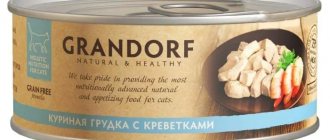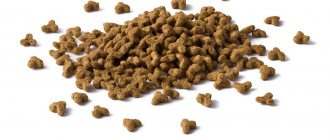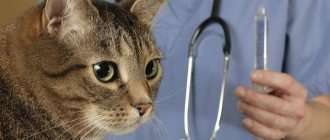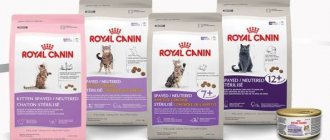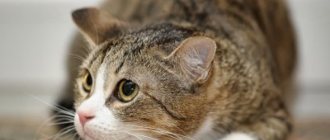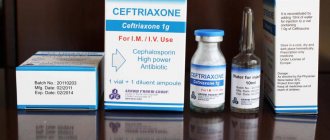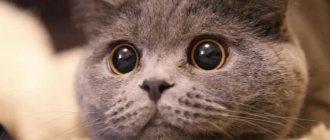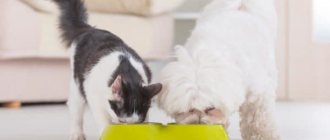A balanced diet is a guarantee of the full development and health of your pet. Not every cat owner has the opportunity to create the right diet, calculate the right ingredients and cook every day.
Moreover, it is not advisable to give treats from your table, since human food contains a lot of seasonings, salt and other components that are harmful to the animal. Therefore, it is worth listening to the advice of veterinarians on what food is best to feed your cat.
Features of feeding kittens
A kitten's diet is radically different from that of adults. He needs the whole complex of vitamins and microelements. As it grows, all vital organs and systems are formed, and a lack of the necessary components will negatively affect health.
A kitten's diet is radically different from that of adults.
For up to 2 weeks, it is recommended to take purely breast milk substitutes, which are sold in pet stores. If they are not available, you can prepare the mixture yourself by combining 4 parts goat or cow milk with 1 part egg white.
As you grow, this nutrition will not be enough. In the 3rd week you need to introduce additional ingredients into the diet. As a supplement, you need to use canned food and dry mixtures for kittens of the premium and super-premium categories.
Meals should be chosen depending on age; this information should be checked with the seller or found on the packaging. It is recommended to combine them with dairy nutrition: 30% is feed, 70% is dairy nutrition.
Advice! You should not purchase cheap products, as they provoke the development of diseases.
Age when you can switch to regular food
It is recommended to completely switch to regular food for the younger age category at 1 month. Formula milk should also continue to be given, but in a smaller dosage. And by 2 months the kitten should be switched to the main type of food. This transition will help avoid stress for your pet.
It is worth changing the product line only as a last resort.
Proper nutrition: basic rules and recommendations
Poor nutrition inevitably entails various diseases (digestive disorders, pancreatitis, gastritis, ulcers, enteritis, poisoning, allergies, diabetes, obesity, cardiovascular diseases, kidney, liver failure, etc.), affects the quality and life expectancy. The fact that many owners are negligent in feeding their dogs is evidenced by the fact that about 40% of all non-communicable diseases are caused by improper diet. In other words, every 5 dogs suffer from the fact that its owner does not bother with the issue of balancing the diet, let alone the need to follow the regime, weight distribution of food and other important rules.
A diet is a daily set of products that meets the body’s needs and contains a certain amount of nutrients (proteins, fats, carbohydrates, vitamins, minerals, etc.), in other words, it must be balanced. The menu is compiled taking into account several factors: age (puppy, teenager, adult, aging and elderly), level of physical activity (home, work, sports), time of year (summer, winter), presence of diseases.
The dog should receive food regularly at the same hours. This way the digestive tract is prepared for the next meal, which ensures high absorption of nutrients. The frequency of feeding depends on age:
- 1-2 months - 5-6 times a day;
- 2-3 months - 4 times;
- 4-12 months - 3 times;
- From one year to 8-9 years - 2 times;
- From 8-9 years old - 3-4 times;
- During pregnancy and lactation - 3-4 times a day.
If the dog has not eaten a portion within 15 minutes, the bowl is removed until the next feeding. If food remains constantly, you need to reduce the portion; if it is eaten quickly and the bowl is licked, you can increase it a little. You should feed your dog 1-2 hours before a walk and the same amount after active physical activity. If the rule is not followed, digestibility deteriorates, and in large breeds the risk of gastric volvulus also increases.
The volume and weight distribution of food should be approximately the same, corresponding to the capacity of the stomach and the abilities of the body. During the day, the daily norm is divided as follows:
- Feeding 4 times a day - 25/20/20/35%;
- 3 times ―20/40/40%;
- 2 times - 40/60%.
If one feeding was missed, regardless of the reasons, the portion at the next meal is not increased, it is given as usual. For street dogs in the cold season, as well as for sports and hunting dogs during periods of increased stress, 1-2 feedings are added, increasing the calorie content of the daily diet by 50-150%.
- The dog’s body must be accustomed to eating liquid porridge, thick soup or dry food of different brands. Smoothly transition from one type of nutrition to another. Carefully introduce new products.
- You cannot offer your dog a choice of food, feed him food from the table, or allow him to eat only tasty things. If the animal is waiting for “pick-up food,” let it starve a little.
- Food must be fresh, prepared from quality products. Its proper storage is important. The bowl should be washed after each feeding, even if it is licked to a shine.
- The dog swallows food in large pieces, so cold food does not have time to warm up, and hot food does not have time to cool down. Feed, with the exception of drying, should be heated to 30-35°C.
- It is important that your dog always has free access to drinking water, especially when feeding dry food.
Food selection for an adult
When choosing natural food, the cat owner should focus on the needs of the animal.
There are 2 food options for an adult pet: ready-made dry/wet ingredients and natural food. Which one to choose, everyone decides for themselves, depending on personal preferences.
But veterinarians advise purchasing finished products that contain all the necessary substances in an accessible form. At the same time, you can diversify your diet with both dry mixture and wet food. The main thing is to choose premium and super-premium products.
You can judge the beneficial properties of a particular product by the condition of the coat (smooth, shiny) and the activity of the animal.
When choosing natural food, the cat owner should focus on the needs of the animal, depending on its age and breed.
Also keep in mind that the diet should include not only meat, but also cereals, vegetable oils, dairy products, vegetables, fish, and eggs.
Be sure to read:
How many times a day to feed a kitten: natural products and food, norms by month
Types of cat food: dry, liquid, raw
It is worth noting that cat food is significantly different from dog food. The fact is that dogs need more carbohydrates and less protein. Since cats are related to carnivores, the diet of these feline pets should contain a large amount of protein and meat products.
Accordingly, cat food contains a lot of protein and a small amount of carbohydrates and fats. However, not all food that is available on store shelves is equally healthy and suitable for your pet.
Types of cat food:
- Dry. These are well-known small balls or plates and can be sold in the form of peas or oblong sticks. They look like dry snacks of different colors. They contain a lot of protein and carbohydrates.
- Liquid food or it is also called canned food. Sold in bags or cans.
- Raw food . This is food for cats that is as close as possible to what happens in the wild. Made from products that can be consumed by humans. Contains fresh raw meat, fish, quail eggs, fruits and vegetables, and may contain oat bran. While there is only a small amount of such food on the Russian market, the main drawback is that they are sold frozen. This is normal practice for European countries, but in our country this method of feeding cats is still unusual.
Food for cats
What should you not feed your cat?
There are certain foods that are strictly forbidden to give to a cat. When planning your diet, you should completely exclude them.
You should not give your pet:
- fatty meat (pork, lamb);
- sweets and sugar analogues;
- spices;
- smoked meats, marinades;
- onion garlic;
- sour foods;
- fried food;
- sausages, sausages;
- fatty fish.
Attention! When preparing natural food, you should not add salt and spices, because... this leads to liver and kidney dysfunction.
Main mistakes when choosing a diet
Not only the stomach suffers from poor nutrition, but also the liver, kidneys, heart, eyesight...
We have already talked about the negative effects of dairy products on the digestive system of tailed animals and the possible risks of feeding human food.
Read on to find out what other annoying mistakes are made in building a diet.
- It is not recommended to mix food types. Either you feed the animal with specialized food or natural food. The cat's body gets used to and adapts to a certain type of diet, frequent changes of which lead to its imbalance. It is difficult for your pet’s body to adjust itself, which can lead to gastroenteritis, and in some cases, intestinal obstruction.
- Feeding a purring dog dog food is no less a mistake. Dog and cat food vary greatly in composition. The point is that these animals have different needs; their bodies require different enzymes. The cat's body does not need as many carbohydrates as dog food abounds. But it contains almost no taurine sulfonic acid, which cats need for normal life. Eating dog food by cats can lead to irreversible consequences; almost all internal organs can suffer from this, not only the gastrointestinal tract, but also the liver, kidneys, heart, and vision.
- Do not feed the animal. Many of the foods, especially wet ones, can be addictive. Cats never tire of persistently begging for them for hours. It is important to understand that if a cat yells, it does not necessarily mean that he is hungry. Perhaps your pet just craves your attention. Try entertaining him by playing instead of filling his bowl with food. In addition, there are breeds that are well known for their gluttony. These include, for example, the insatiable British. They are constantly hungry and do not know how to stop. Such cats need to be taught the rules of eating behavior from childhood; we recommend dividing the food 2-3 times: give it in the morning, afternoon and evening. This way the cat will know exactly when he will be fed.
Feed classification
All ready-made mixtures are divided into certain categories depending on quality, composition, usefulness and pricing policy. To understand the difference, it is worth familiarizing yourself with all types separately.
Economy class
Economy class cat food
These products are the most affordable . Its function is the ability to quickly satisfy hunger, filling the stomach, but it cannot be considered as the main food.
Economy class is comparable to the fast food that a person uses. It allows you to fill your stomach and give you a feeling of fullness, but has practically no beneficial properties.
In the production of this category, by-products, soybeans and a large number of grains are used. To ensure that food has an appetizing smell and taste, flavorings, flavor enhancers and colorings are added to it.
Popular representatives:
- Kitikat;
- Whiskas;
- Friscas;
- Felix;
- Oscar.
Important! This category does not provide any benefit to the body, so veterinarians do not recommend using it as the basis of the diet due to the low protein content and vitamin complex supplements.
Middle class
This line surpasses economy class in its useful qualities. The feed contains by-products, but of high quality. The volume of soybeans and grains used in production has been significantly reduced.
The content of flavors and other harmful additives is minimized. The calorie content of the product is higher due to better digestibility of the incoming substances. This allows the daily consumption rate to be significantly reduced.
Manufacturers:
- Cat Chow;
- Karma Organic;
- Perfect Fit.
The label of medium category products must contain the following information:
- protein content (at least 25%) and its source of origin (specific name of meat);
- the presence of fish and liver, which are a source of vitamin A, E;
- daily consumption rate (the lower this figure, the better);
- concentration of by-products, cereals, soy and chemicals (no more than 50%);
- best before date;
- the abbreviation AAFCO, which confirms the passage of quality control.
If this information is not on the packaging, then it is not worth buying the product.
Premium class
This category differs in meat content, but does not exclude the presence of offal and vegetable protein. During production it is enriched with vitamins and microelements, which significantly improves the benefits of its use.
When purchasing, you should pay attention to the content of rice, grains and corn grits. The higher their content, the lower the quality.
Be sure to read:
Can cats have sweets: when is it necessary, in what form is it allowed, benefits and harms, why not?
Manufacturers:
- Nutro Choice;
- Royal Canin;
- Eukanuba;
- Bozita.
When choosing a premium class, owners can expect that this product will not cause harm to health, and the benefits will be tangible. This property explains the popularity of premium products.
Super premium class
This category refers to high quality types. It contains meat, fish and all useful components for full development.
No chemical components that improve taste and smell are introduced during production. All components included in the product are clearly indicated on the packaging. It is impossible to find anything unnecessary, as the product undergoes strict quality control.
The reduction in daily intake is achieved by a high percentage of components digestibility. This justifies the cost of the super-premium category, since to replenish the pet’s strength it is enough to eat a small amount of food.
Manufacturers;
- Nutram;
- Arden Grange;
- Brit Care;
- Acana;
- Farmina N&D.
Dangerous cat food: what should be the composition of cat food?
As you can see, there are a huge number of pet foods, but not all of them are the best and may be beneficial for your pet. Please note that for sterilized cats, as well as neutered cats, the protein content in the food may be slightly lower than for animals that can reproduce.
This is due to changes in the body and its needs. Accordingly, before purchasing any food, consult your veterinarian. He will adequately assess the condition of your animal and also recommend special types of food that will be suitable specifically for your pet.
Why cheap cat food is dangerous:
- High content of preservatives and flavor enhancers. The fact is that the animal very quickly gets used to this food, and after that it does not want to eat any other food. This is done by food manufacturers in order to hook the animal on this particular product.
- Never rely on advertising or trust it. Most of the products that can be seen on television for cats do not meet animal standards. It contains a lot of bone meal, cartilage, preservatives, and also grains. Instead of meat, offal is added. That is, these are offal, intestines, skin, as well as ears and tails of pigs, cows and other animals.
- A lot of chicken or goose skin, which are high in fat but low in nutrients. Such food does nothing other than obesity and excessive stress on the kidneys. Quite often, to increase the protein content, modified soybeans are added to cheap food. A lot of flour and also starch. All this can hardly be called a balanced diet for a cat, and even less useful.
- We advise you not to purchase cat food in supermarkets, because they usually sell economy-class products. That is, this is the well-known KitiKat, or Whiskas. It contains few healthy ingredients and virtually no natural meat. If you really want to buy high-quality and healthy food for your pet that will contain a balanced amount of proteins, fats and carbohydrates, we recommend that you seek help from a veterinarian. You can also purchase high-quality food on the Internet or in veterinary clinics.
Cat food
Dry mixes
This type of food is most popular due to the preservation of nutritional properties for a long time. It is convenient because you can pour it in once every few days without worrying about the food spoiling.
Be sure to place a bowl of clean water near the feeder, since a lack of moisture in food provokes increased thirst.
Crispy pieces are useful not only for their composition, but also for their ability to clean plaque from teeth. Store reserves of the dry mixture in closed packaging, since prolonged contact with air reduces the beneficial properties.
Main varieties
The intensity of the debate over whether to feed cats formulas developed for four-legged animals with human food or to mix the two types has not subsided, probably since the appearance of the first specialized stores. And if we add to this animals with special health conditions (castrated/sterilized), older ones, and rare breed cats, the questions become even greater. Therefore, we will understand this global topic in order, starting from the very basics.
Experts do not recommend mixing animal and human food.
The new owner of a furry creature has 3 options when choosing what to feed it: special food, human food, or a mixed option. If you talk to experts about what food is best to feed your cat, they will definitely say: it is better to choose specialized food because it contains everything your pet needs, that is, because it is balanced. You can choose the option of feeding natural products. It will not harm the animal, provided that the diet is varied. And this will cause more trouble, especially for those who are limited in time.
Experts do not recommend mixing animal and human food, since maintaining a balance in this case will be extremely difficult, which can significantly harm the pet due to a lack of one element and an excess of another. First, let's look at the classifications of special feeds. Globally they are divided into 3 groups:
- canned food;
- liquid;
- dry.
Canned food for cats contains quite a lot of liquid.
Almost all four-legged animals like canned food, even the extremely picky ones. They come in tin cans and contain quite a lot of liquid, which is perfect for those cats who drink a little. They are stored for a long time, especially if, after opening the jar, the remaining contents are transferred to a glass container. Therefore, it is better to give your pet exactly as much as he can eat at one time.
Wet food contains liquid within 35%, which is much less than canned food. It is considered a middle form between crackers and canned food, and is available in very convenient bags designed for one feeding.
Know! You should not leave uneaten pieces in the bowl. They dry out quickly, losing not only their value, but also their basic attractiveness.
Dry food is probably known even to those who don’t keep cats. These are boxes of crackers that contain absolutely no moisture. Therefore, there must be a drinking bowl next to the bowl: you need to wash down solid food with plenty of water, and immediately after eating it. Rusks are useful for cats' oral cavity in terms of cleaning teeth. In the process of gnawing, plaque is removed very well, which is the prevention of dental diseases.
Dry food is useful for cats' oral cavity in terms of cleaning teeth
Which diet is better: wet or dry?
It is impossible to answer this question unequivocally, because a pet needs variety in its diet and nutritional components. The best option is a combination of these types of food, but of the same category.
Veterinarians recommend using wet food for breakfast and dinner, and adding dry food during the day. This will allow you to achieve optimal balance in your diet.
Which diet is better: wet or dry?
Natural food for cats
When choosing natural products, you need to focus on the needs of the animal. This depends on his level of health, age, breed and activity level.
This diet should include:
- low-fat fermented milk products;
- boiled meat of lean varieties;
- high-quality offal (liver, heart, stomachs);
- vegetables, greens of neutral taste;
- lean fish without bones;
- vegetable oils;
- cereals;
- egg yolks.
The diet should be supplemented with vitamins and minerals depending on the time of year, breed and age. These components should be administered on the recommendation of a veterinarian in accordance with the indicated dosage. It is important to use healthy supplements in the autumn and spring.
Food from your table
Some owners, in order not to rack their brains over the problem of what food is best to feed their cat, choose natural food. This is a more labor-intensive path, since the owner will have to calculate the balance, composition, and calorie content of the diet independently. Everything will depend again on age, health, coat length, breed, temperament. Your pet should definitely consume:
- porridge;
- cottage cheese;
- meat;
- eggs;
- fruits vegetables.
Fish is contraindicated for cats.
Meat should be chosen exclusively dietary, from cereals - only buckwheat, rice. It is not recommended to give milk to animals (lactose is not digested by the body), or fish. It is harmful to cats, especially neutered ones. This rightly raises the question of what food is best to feed a sterilized cat or a neutered male. If we are talking about natural food, it should be exclusively dietary (poultry, vegetables, eggs, grass for cats or any sprouted greens). No fatty foods, smoked foods, or salty foods. If we are talking about industrial food, you need to choose food specifically for sterilized/neutered animals. They are somewhat more expensive, but other foods are completely unsuitable in this case; on the contrary, they even harm the special condition of your pet.
Feed rating
Of the entire variety of products, several stand out whose price and benefit indicators are acceptable. Using them as the basis of nutrition allows you not to worry about your pet’s well-being.
Be sure to read:
Food for sphinxes, what to feed a kitten and an adult cat: menu by month
Rating of the most useful types:
- Orijen – animal protein content – 42%.
- Acana – high concentration of fish and poultry fats.
- NOW Natural – increased content of fish oil.
- Bosch SANABELLE - the basis is dietary poultry and fish.
- 1st Choice – protein content – 28-30%, based on rabbit, fish, poultry meat.
- Arden Grange - 25-26% vegetable components, the rest is meat, also contains dried egg.
- Hill's - main ingredients: beef, poultry, rabbit.
- Royal Canin – contains animal and plant proteins.
HOW TO READ FEED LABELS?
It is important to pay attention to the list of ingredients on the packaging. Ingredients are listed in descending order of their proportion by weight. Accordingly, the first few ingredients indicate the main sources of protein. In canned food, the first ingredient is, of course, water.
You may see the word “offal” in the list of ingredients.
These include feathers, hooves, teeth, heads, fur, horns, and stomach or intestinal contents. Some owners are suspicious of foods that list by-products as one of the ingredients, but lungs, kidneys and other organs that are also classified as by-products are an excellent source of protein. Remember that when a cat eats a mouse, it also eats these by-products.
Among other things, the label also indicates the content of vitamin and mineral additives, as well as preservatives, in the food.
Next, we will consider the types of feed by class.
Composition analysis
When choosing, you need to carefully study the composition of the product. It should contain useful components to the maximum, and harmful ones - in minimal quantities.
Substances indicated in the composition, the presence of which is undesirable:
- sugar, its analogues:
- dye E12, which increases the likelihood of the formation of malignant tumors;
- high content of harmful by-products (skin, feathers, beaks);
- meat without indicating its source;
- antioxidants that damage the liver: E320, 324, 321;
- flavorings;
- flavor enhancers.
The quality of nutrient mixtures of wet and dry consistency can be recognized if the ratio of healthy products in their composition does not differ significantly from the following indicators:
- meat, with exact indication of name – 35%;
- protein – 20%;
- high quality by-products – 10%;
- plant matter – 25%.
A whole complex of vitamins and mineral components should also be present.
Reading the packaging
When choosing food, it is very important to carefully read everything written on the packaging. It is this information that can either persuade you to purchase, or make you wary, even make you refuse to purchase.
The presence of hazardous chemical elements destroys the digestive system
Attention! You can purchase a product if its box contains the word balanced, the AAFCO (America Quality Control Association) mark, meat content of at least 25%, and the presence of vitamins C and E.
Also, when figuring out which liquid food is best to feed your cat, pay attention to its quantity for one meal: the smaller the quantity, the higher the absorption, the better the quality of the food. Sources of protein should be liver or fish.
You should immediately refuse the purchase if on the packaging you find the words by-product, bone meal, ethoxyquin, BHA, propyl gallate, BHT. It is strictly forbidden to buy formulations that contain wheat, corn, other fillers, flavors, or dyes. The presence of dangerous chemical elements destroys the digestive system and internal organs of the pet, which can ultimately lead to serious illnesses and even death.
What diet do veterinarians recommend?
There is no convinced opinion that you should use only industrial food or natural food. The main thing is not to combine these two types of nutrition with each other.
But the opinions of professionals are inclined towards the use of ready-made nutritional mixtures, since they have a balanced composition.
Basic nutrition rules:
- Choose premium or super-premium ready-made nutritional products.
- When using dry nutritional mixtures, be sure to place a bowl of clean water nearby.
- Food must have a high level of digestibility.
- Do not mix canned and dry mixtures at the same time.
- You need to select a dry product with small granules.
- Do not pour large portions, as many pets do not have a sense of proportion.
- Use a nutritional product in accordance with the age category.
- Do not mix products of different qualities.
It is important to use not only high-quality food, but also to learn how to use it correctly. Only in this case will the pet be healthy, active, and its coat will become smooth and shiny.
Is it possible to give a pet a treat?
Our pets are full-fledged members of the family, so we can’t do without treating them to something tasty, because, after all, besides affection and play, there are no other ways to please your pet (expensive perfume and a new iPhone are unlikely to will they be impressive...) In addition, treats are a very effective way of rewarding when training dogs and, in general, rewards for good behavior; they are also indispensable when carrying out procedures that are unpleasant for the pet.
Therefore, of course, it is possible and necessary to treat, but, as in any matter, you need to know when to stop. When, between meals, a dog or cat continuously receives tasty morsels from each family member, then, naturally, they will not have any appetite for dry food. It will turn out the same way as happens with people - I ate too much cake, and therefore refused vegetable salad and soup...
The share of treats should be no more than 10% of the total volume of dry food per day. If it is a dry or dried treat, then it is easy to calculate; if it is wet, then multiply the number you get by four. For example, 10% of 100 g of dry food is 10 g, respectively, dehydrated treats should be given no more than 10 g, and wet treats - no more than 40 g.

